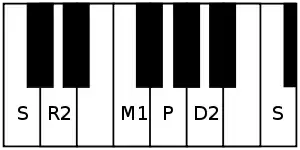Shuddha Saveri
Shuddha Saveri or śuddha sāveri is a rāgam in Carnatic music (musical scale of South Indian classical music) and Yakshagana music. It is an audava rāgam (or owdava rāgam, meaning pentatonic scale). It is a janya rāgam (derived scale)of the Melakarta ragam Dhīraśaṅkarābharaṇaṃ which is 29th Melakarta raga. In Hindustani music it is called Durga.[1][2] According to the school of Muthuswami Dikshitar, this rāgam is called Devakriya.[1][2] Karnataka Shuddha Saveri, a janya rāgam of 1st melakarta Kanakangi, is called Shuddha Saveri by the Dikshitar school.[2]
| Arohanam | S R₂ M₁ P D₂ Ṡ |
|---|---|
| Avarohanam | Ṡ D₂ P M₁ R₂ S |
| Carnatic music |
|---|
 |
| Concepts |
| Compositions |
| Instruments |
|
Structure and Lakshana

Shuddha Saveri is a symmetric rāgam that does not contain gāndhāram or nishādam. It is a pentatonic scale (audava-audava ragam in Carnatic music classification – audava meaning 'of 5'). Its ārohaṇa-avarohaṇa structure (ascending and descending scale) is as follows (see swaras in Carnatic music for details on below notation and terms):
- ārohaṇa : S R₂ M₁ P D₂ Ṡ[lower-alpha 1]
- avarohaṇa : Ṡ D₂ P M₁ R₂ S[lower-alpha 2]
It is a scale that uses the following variants of the swaras – chatushruti rishabham, shuddha madhyamam, panchamam and chatushruti dhaivatam.
Shuddha Saveri is considered a janya rāgam of Sankarabharanam, the 29th melakarta rāgam,[2] though it can be derived from other melakarta rāgams, Kharaharapriya, Gourimanohari or Harikambhoji, by dropping both gāndhāram and nishādam.
Popular compositions
Here are some popular kritis composed in Shuddha Saveri.
- Darinē telusukonṭi and Kālaharaṇamēla rā harē by Tyagaraja in Telugu
- Taye tripura sundari by Periyasaamy Thooran
- Janani pahi sada (Navarathri 7th Day krithi) by Swathi Thirunal
Ānalekara, which is set to this rāgam, is one of the first few geetams (very short compositions) taught to beginners.
- Shri guruguha tarayashu mam by Muthuswami Dikshitar
- sarvajīva dayākarī by Oothukkadu Venkata Kavi is also popular
- kamala-vilochani by Hari Sundareswara sharma
- shankara gangadhara shrikantha and shrimat simhasaneshvari by Muthiah Bhagavatar
- Veedhula Veedhula by Annamacharya
Film Songs
Language:Tamil
Related rāgams
This section covers the theoretical and scientific aspect of this rāgam.
Graha bhedam
Shuddha Saveri's notes when shifted using Graha bhedam, yields 4 other major pentatonic rāgams, namely, Mohanam, Hindolam, Madhyamavati and Udayaravichandrika (also known as Shuddha Dhanyasi). Graha bhedam is the step taken in keeping the relative note frequencies same, while shifting the shadjam to the next note in the rāgam. See Graha bhedam on Mohanam for more details and illustration of this concept.
Scale similarities
- Sālaga Bhairavi is a rāgam which has the ascending scale of Shuddha Saveri and descending scale of Kharaharapriya. Its ārohaṇa-avarohaṇa structure is S R2 M1 P D2 S : S N2 D2 P M1 G2 R2 S
- Yadhukula Kambhoji is a rāgam which has the ascending scale of Shuddha Saveri and descending scale of Harikambhoji. Its ārohaṇa-avarohaṇa structure is S R2 M1 P D2 S : S N2 D2 P M1 G3 R2 S
- Ārabhi is a rāgam which has the ascending scale of Shuddha Saveri and descending scale of Sankarabharanam. Its ārohaṇa-avarohaṇa structure is S R2 M1 P D2 S : S N3 D2 P M1 G3 R2 S
- Devagāndhāri is a rāgam which has the ascending scale of Shuddha Saveri and descending scale of Shankarabharanam. Its ārohaṇa-avarohaṇa structure is S R2 M1 P D2 S : S N3 D2 P M1 G3 R2 S (there are differences in intonation, swara phrases, prayoga, bhava and rasa between this rāgam and Ārabhi, though scale notation in simple terms are same)
- Janaranjani is a rāgam which has the ascending scale of Shankarabharanam and descending scale of Shuddha Saveri. Its ārohaṇa-avarohaṇa structure is S R2 G3 M1 P D2 N3 S : S D2 P M1 R2 S
- Karnataka Shuddha Saveri of Dikshitar school has Shuddha Rishabham in place of Chatushruti Rishabham and Shuddha Dhaivatam in place of Chatushruti Dhaivatam. Its ārohaṇa-avarohaṇa structure is S R1 M1 P D1 S : S D1 P M1 R1 S.
Notes
- Alternate notations:
- Hindustani: S R M P D Ṡ
- Western: C D F G A C
- Alternate notations:
- Hindustani: Ṡ D P M R S
- Western: C A G F D C
References
- Ragas in Carnatic music by Dr. S. Bhagyalekshmy, Pub. 1990, CBH Publications
- Raganidhi by P. Subba Rao, Pub. 1964, The Music Academy of Madras